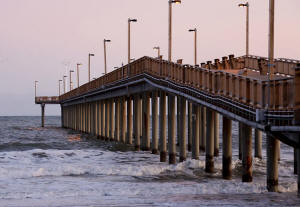Once known as 'Dirty Myrtle,' Myrtle Beach is now the fastest-growing US
metro for seniors
[July 02, 2025]
By MIKE SCHNEIDER
A South Carolina beach town once nicknamed “Dirty Myrtle” because of its
rowdy nightclubs and strip joints has become a magnet for retirees in a
nation that continues to age.
The number of residents age 65 years and older in the Myrtle Beach
metropolitan area grew by 6.3% last year, making it the fastest-growing
metro area for senior citizens in the U.S., according to population
estimates the U.S. Census Bureau released last week.
During the 2020s, Myrtle Beach's senior population has grown by more
than 22%, also the fastest rate in the United States this decade. Senior
citizens now make up more than a quarter of the around 413,000 residents
in metro Myrtle Beach, which once was known for being a budget beach
destination.
The community with a mile-long boardwalk and 200-foot Ferris wheel used
to attract biker rallies which the city tried to end in the late 2000s
because of the noise, traffic and rowdiness. But now the noisy streets
have had to make room for quiet diners and pickleball courts.
The COVID-19 pandemic played a role in the area's senior boom as people
in such places as Ohio and New York who had been vacationing for years
in Myrtle Beach realized they could retire early or work from home
anywhere, said Mark Kruea, a longtime public information officer for
Myrtle Beach who is now running to be mayor.
“Many people converted that thought into action,” Kruea said. “The
climate's great, taxes are low, there's a wealth of opportunities for
recreation, dining and shopping.”

A graying United States
The U.S. population age 65 and older rose by 3.1% last year, while the
population under age 18 decreased by 0.2%. In the past two decades,
seniors have increased from 12.4% to 18% of the U.S. population, while
the share of children has dropped from 25% to 21.5%, according to the
population estimates.
Maine, Vermont, and Florida were the only three states where older
adults outnumbered children as recently as 2020. But four years later,
those states were joined by Delaware, Hawaii, Montana, New Hampshire,
Oregon, Pennsylvania, Rhode Island and West Virginia.
Maine last year had the oldest median age at 44.8, while Utah’s was the
youngest at 32.4.
[to top of second column]
|

The sun starts setting near the Springmaid Pier, Feb. 4, 2023, in
Myrtle Beach, S.C. (AP Photo/Chris Seward, file)
 Groups that saw the most growth
The share of the U.S. population that is Hispanic reached 20% last
year for the first time, helped by an annual gain of 1.9 million
Hispanics mostly through migration. In pure numbers, the Hispanic
population grew the most last year in the New York, Houston and
Miami metro areas. When it comes to growth rates, the biggest gains
were in smaller metros such as Ocala, Florida; Panama City, Florida;
and St. Joseph, Missouri.
For Black residents whose growth last year was split between
migration and natural increase, the biggest gains were in the
Houston, New York and Dallas-Fort Worth metro areas in pure numbers.
Bozeman, Montana, and Provo, Utah — metro areas with tiny Black
populations to start with — were tops in growth rates.
In pure numbers, the New York, Dallas-Fort Worth and Seattle metro
areas had the biggest Asian population gains, and the growth came
primarily from migration. The largest growth rates were in three
metro areas with small Asian populations: Farmington, New Mexico;
Bismarck, North Dakota; and Burlington, North Carolina.
The non-Hispanic white population in the United States declined
slightly last year, but it grew the most in the Nashville,
Tennessee; New York and Charlotte, North Carolina metro areas in
pure numbers. The biggest growth rates for the white population were
in the Myrtle Beach; Daphne-Fairhope, Alabama; and Wilmington, North
Carolina metro areas.
The decline in the white population was driven by deaths outpacing
births.
All contents © copyright 2025 Associated Press. All rights reserved
 |